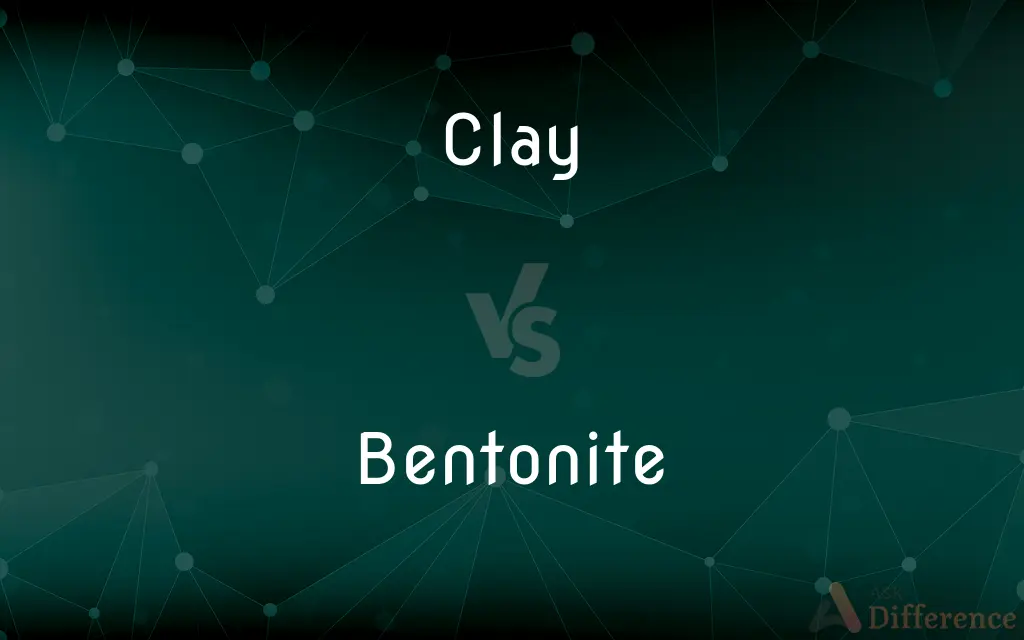Clay vs. Bentonite — What's the Difference?
Edited by Tayyaba Rehman — By Maham Liaqat — Updated on April 6, 2024
Clay is a natural, fine-grained soil material with plasticity, used in ceramics and construction, whereas bentonite is a specific type of highly absorbent clay known for its uses in drilling fluids and sealing.

Difference Between Clay and Bentonite
Table of Contents
ADVERTISEMENT
Key Differences
Clay is a broad category of natural, earthy materials known for their plasticity when wet and hardening when fired or dried. They are primarily composed of minerals with fine particles and find wide application in pottery, brick making, and as a natural building material. Bentonite, on the other hand, is a specific type of clay that is particularly known for its swelling properties and high absorbency. It is composed mainly of montmorillonite and is used in a variety of industrial and health applications.
While all bentonites are clays, not all clays are bentonite. The distinguishing feature of bentonite is its ability to swell and increase in volume when exposed to water, whereas other clays may not exhibit such a high degree of swelling. This characteristic makes bentonite especially valuable in applications that require the absorption and sealing of liquids.
Clay sources are widespread and can be found in many parts of the world, reflecting a diversity of geological processes and histories. Clays are extracted from the earth and often require minimal processing before use in various applications. The availability and type of clay can significantly affect its suitability for specific uses.
Bentonite clay is mined from deposits that formed from volcanic ash in seawater millions of years ago. The largest known source of bentonite clay is in the Western United States, specifically in Wyoming. The extraction and processing of bentonite can be more specialized than for other clays, reflecting its unique properties and applications.
Comparison Chart
Composition
Varied minerals, primarily kaolinite and silica
Primarily montmorillonite
ADVERTISEMENT
Swelling
Generally low to moderate
High, absorbs several times its weight in water
Applications
Pottery, construction, ceramics
Drilling fluids, sealants, health products
Source
Worldwide, diverse geological formations
Volcanic ash deposits, mainly in the Western US
Absorbency
Varies depending on the type
Extremely high
Compare with Definitions
Clay
Used for making bricks, pottery, and ceramics.
Clay ovens are traditional in many cultures.
Bentonite
A type of clay that swells in water.
Bentonite is used in water-based drilling fluids.
Clay
A natural, earthy material that is plastic when wet.
Artists use clay for sculpting.
Bentonite
Used in wine making to clarify the wine.
Bentonite helps remove impurities from wine.
Clay
A component of soil, affecting its fertility and water-holding capacity.
Rich clay soils are excellent for gardening.
Bentonite
Known for its high absorbency and sealing properties.
Bentonite liners are used in landfills.
Clay
Can be used as a natural building material.
Clay is used in adobe construction.
Bentonite
Used in health supplements and beauty products.
Bentonite clay is believed to remove toxins.
Clay
Acts as a natural detoxifier in health and beauty products.
Clay masks are popular for skin care.
Bentonite
Can clump and seal, making it ideal for cat litter.
Bentonite cat litter controls odor well.
Clay
Clay is a type of fine-grained natural soil material containing clay minerals. Clays develop plasticity when wet, due to a molecular film of water surrounding the clay particles, but become hard, brittle and non–plastic upon drying or firing.
Bentonite
Bentonite () is an absorbent swelling clay consisting mostly of montmorillonite. It usually forms from weathering of volcanic ash in seawater, which converts the volcanic glass present in the ash to clay minerals.
Clay
A stiff, sticky fine-grained earth that can be moulded when wet, and is dried and baked to make bricks, pottery, and ceramics
A clay soil
A clay tile
The soil is mainly clay
The rocks are covered by various mixtures of loose clays and sands
Bentonite
An absorbent aluminum silicate clay formed from volcanic ash and used in various adhesives, cements, and ceramic fillers.
Clay
A European moth with yellowish-brown wings.
Bentonite
(mineral) Any of several impure clay minerals consisting mostly of montmorillonite.
Clay
A fine-grained, firm earthy material that is plastic when wet and hardens when heated, consisting primarily of hydrated silicates of aluminum and widely used in making bricks, tiles, and pottery.
Bentonite
A porous clay formed by the decomposition of volcanic ash that swells 5 to 6 times its original volume in the presence of water.
Clay
A hardening or nonhardening material having a consistency similar to clay and used for modeling.
Bentonite
An absorbent aluminum silicate clay formed from volcanic ash.
Clay
(Geology) A sedimentary material with grains smaller than 0.002 millimeter in diameter.
Bentonite
An absorbent aluminum silicate clay formed from volcanic ash
Clay
Moist sticky earth; mud.
Clay
The human body as opposed to the spirit.
Clay
A mineral substance made up of small crystals of silica and alumina, that is ductile when moist; the material of pre-fired ceramics.
Clay
An earth material with ductile qualities.
Clay
(tennis) A tennis court surface made of crushed stone, brick, shale, or other unbound mineral aggregate.
The French Open is played on clay.
Clay
(biblical) The material of the human body.
Clay
(geology) A particle less than 3.9 microns in diameter, following the Wentworth scale.
Clay
A clay pipe for smoking tobacco.
Clay
A clay pigeon.
We went shooting clays at the weekend.
Clay
(informal) Land or territory of a country or other political region, especially when subject to territorial claims
Danzig is rightfully German clay.
Clay
(transitive) To add clay to, to spread clay onto.
Clay
To purify using clay.
Clay
A soft earth, which is plastic, or may be molded with the hands, consisting of hydrous silicate of aluminium. It is the result of the wearing down and decomposition, in part, of rocks containing aluminous minerals, as granite. Lime, magnesia, oxide of iron, and other ingredients, are often present as impurities.
Clay
Earth in general, as representing the elementary particles of the human body; hence, the human body as formed from such particles.
I also am formed out of the clay.
The earth is covered thick with other clay,Which her own clay shall cover.
Clay
To cover or manure with clay.
Clay
To clarify by filtering through clay, as sugar.
Clay
A very fine-grained soil that is plastic when moist but hard when fired
Clay
Water soaked soil; soft wet earth
Clay
United States general who commanded United States forces in Europe from 1945 to 1949 and who oversaw the Berlin airlift (1897-1978)
Clay
United States politician responsible for the Missouri Compromise between free and slave states (1777-1852)
Clay
The dead body of a human being
Common Curiosities
How are clay and bentonite different?
Bentonite is a type of clay with unique swelling and absorbency properties, making it distinct from other clays that may not swell as much.
What is clay?
Clay is a natural, fine-grained soil material known for its plasticity when wet and hardening when dried or fired.
Where is bentonite found?
Bentonite is primarily found in deposits formed from volcanic ash, with a significant concentration in the Western United States.
Can all clays swell like bentonite?
No, not all clays have the high swelling properties of bentonite. Bentonite's ability to absorb several times its weight in water sets it apart.
Are clays renewable?
Clays are considered a natural resource, but they are not renewable within a human lifespan. Sustainable mining practices are important for conservation.
What is bentonite?
Bentonite is a specific type of clay known for its high swelling and absorbency properties, used in various industrial and health applications.
Is bentonite edible?
Food-grade bentonite is used in certain health supplements and is considered safe for consumption in small amounts.
How is bentonite processed?
Bentonite is processed through drying, crushing, and then milling to produce different grades and forms for various applications.
How does the absorbency of clay and bentonite compare?
Bentonite's absorbency is significantly higher than that of other clays, making it unique in its ability to swell and absorb water.
What are the uses of clay?
Clay is used in making pottery, ceramics, bricks, and in construction. It also has applications in health and beauty products.
What are the uses of bentonite?
Bentonite is used in drilling fluids, as a sealant, in health supplements, beauty products, and in wine making to clarify wine.
How do clay and bentonite affect the environment?
The mining and processing of clay and bentonite can impact the environment; sustainable practices are essential to minimize these effects.
Can bentonite be used in construction?
Yes, bentonite is used in construction as a sealant, especially in foundations and to prevent water leakage.
Are there synthetic alternatives to bentonite?
While there are synthetic materials with similar properties, bentonite's unique natural composition and benefits are difficult to replicate fully.
Can clay be used for health purposes?
Yes, certain types of clay, including bentonite, are used in health and beauty products for their detoxifying properties.
Share Your Discovery

Previous Comparison
Yo vs. Sup
Next Comparison
Miscomprehension vs. MisapprehensionAuthor Spotlight
Written by
Maham LiaqatEdited by
Tayyaba RehmanTayyaba Rehman is a distinguished writer, currently serving as a primary contributor to askdifference.com. As a researcher in semantics and etymology, Tayyaba's passion for the complexity of languages and their distinctions has found a perfect home on the platform. Tayyaba delves into the intricacies of language, distinguishing between commonly confused words and phrases, thereby providing clarity for readers worldwide.















































